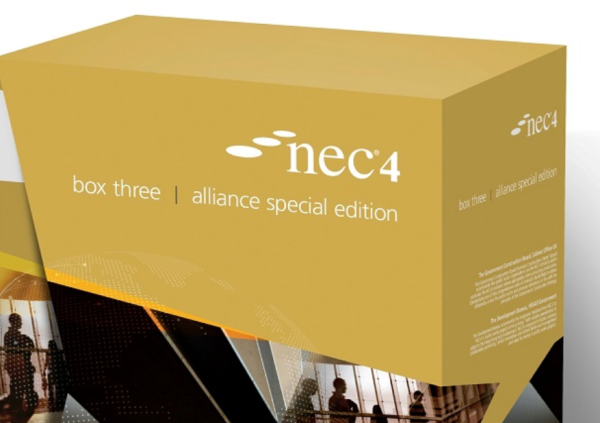NEC4 contract creates a procurement alliance arrangement for all stakeholders

|
| ICE’s collaborative NEC contract suite is the infrastructure procurement route of choice in the UK, Hong Kong, South Africa and New Zealand. In this article, Ian Heaphy introduces the latest member of the family, the NEC4 Alliance Contract. |
Contents |
[edit] Introduction
Following extensive industry consultation, ICE’s NEC division launched the NEC4 Alliance Contract (ALC) at the NEC Users’ Group annual seminar in London earlier this year.
The contract marks the next stage in NEC’s 25-year history of collaborative construction procurement and creates a ‘true’ alliance arrangement, where the client and all key members of the supply chain are engaged under a single set of conditions of contract.
All members of an ALC alliance have an equal voice and share in the performance of the alliance as a whole, as opposed to their own individual performance.
The contract is designed for use on major projects or programmes of work, where longer-term collaborative ways of working are to be created.
It can also be used to deliver a programme where a number of lower-value projects can be combined to create a major programme of work.
[edit] NEC approach to alliancing
All contracts in the NEC4 contract suite, which was launched in 2017, and their predecessors are collaborative in nature. They allow all key members of the supply chain to be engaged under contracts that contain the requirement at clause 10.2 for the parties to, "act in a spirit of mutual trust and co-operation".
Further collaboration can be achieved using secondary option X12 multi-party collaboration, which incentivises multiple suppliers to collaborate to achieve a common set of objectives set by the promotor (commonly the client).
ALC takes this further, building option X12 into the core of the contract.
Members of the alliance are thus required to collaborate with each other to achieve alliance objectives and individual member objectives. They work collectively to support delivery of the contract and establish an integrated alliance delivery team on a best-for-project basis.
[edit] Structure of the alliance
The client has a dual role in the ALC in that it has certain retained powers and functions that it performs outside of the alliance, as well as the power and functions of an alliance member.
An alliance board has overall responsibility for the alliance and sets strategy, appoints an alliance manager, makes decisions and resolves disputes.
Each alliance member has an alliance board representative, including the client.
The alliance manager manages the contract on behalf of the alliance and undertakes many of the functions exercised by the project manager or service manager under other NEC contracts, as well as some aspects of the contractor’s role.
Reflecting the collaborative nature of the contract, the majority of decisions of the alliance have to be made unanimously by the alliance board.
Alliance members share the majority of risk under the contract and agree that there can be no claims made against other members of the alliance except for very limited exceptions, principally due to a deliberate breach of contact.
[edit] Performance table
Payment by the client to other alliance members, which are referred to as partners, is on the basis of defined cost.
All partners are incentivised to achieve alliance objectives through a performance table, which sets out what performance is required and the reward or deduction regimes that apply if the performance targets are over- or under-achieved.
There’s already been considerable interest in the ALC from NEC users. The new contract also supports ICE’s Project 13 initiative to shift infrastructure procurement from transactions to enterprises.
This article is based on the author’s briefing article in the latest issue of the ICE Civil Engineering journal and originally appeared at: https://www.ice.org.uk/news-and-insight/the-civil-engineer/november-2018/new-nec4-contract-creates-true-alliance
--The Institution of Civil Engineers
[edit] Related articles on Designing Buildings Wiki
- ICE articles on Designing Buildings Wiki.
- ICE Conditions of Contract.
- NEC contract change management systems.
- NEC contracts and collaborative working.
- NEC4 - legal and insurance aspects.
- NEC4 Alliance contract.
- NEC4 Design, Build and Operate Contract.
- NEC4.
- Partnering.
- Procurement route.
- Project 13.
- The Institution of Civil Engineers.
Featured articles and news
Infrastructure that connect the physical and digital domains.
Harnessing robotics and AI in challenging environments
The key to nuclear decommissioning and fusion engineering.
BSRIA announces Lisa Ashworth as new CEO
Tasked with furthering BSRIA’s impressive growth ambitions.
Public buildings get half a million energy efficiency boost
£557 million to switch to cleaner heating and save on energy.
CIOB launches pre-election manifesto
Outlining potential future policies for the next government.
Grenfell Tower Inquiry announcement
Phase 2 hearings come to a close and the final report due in September.
Progress from Parts L, F and O: A whitepaper, one year on.
A replicated study to understand the opinion of practitioners.
ECA announces new president 2024
Electrical engineer and business leader Stuart Smith.
A distinct type of countryside that should be celebrated.
Should Part O be extended to existing buildings?
EAC brands heatwave adaptation a missed opportunity.
Definition of Statutory in workplace and facilities management
Established by IWFM, BESA, CIBSE and BSRIA.
Tackling the transition from traditional heating systems
59% lack the necessary information and confidence to switch.
The general election and the construction industry
As PM, Rishi Sunak announces July 4 date for an election.
Eco apprenticeships continue help grow green workforce
A year after being recognised at the King's coronation.
Permitted development rights for agricultural buildings
The changes coming into effect as of May 21, 2024.






















